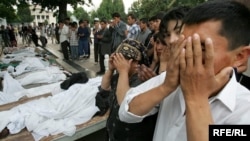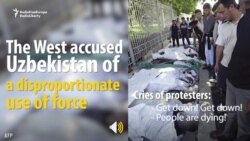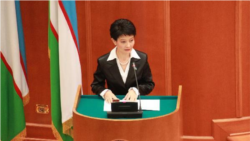
On the morning of May 13, 2005, a group of armed men -- some of them recently escaped from prison -- stormed into Uzbekistan's eastern city of Andijon.
They killed some government officials and took others hostage.
A peaceful protest involving hundreds of locals had been going on in Andijon for several days prior to May 13.
Order broke down and the armed group, the peaceful protesters, and curious residents of the city all mixed in the streets.
Just seven weeks before, Central Asian leaders had watched with great concern as Kyrgyz President Askar Akaev had been ousted from power in a popular revolution in late March.
Determined not to allow a repeat of those events in Kyrgyzstan, authoritarian President Islam Karimov called in the military to restore order in Andijon.
It was a bloodbath.
According to the Uzbek government, 187 people were killed, most of them soldiers and insurrectionists. Civilian deaths, only about 60 according to the Prosecutor-General's Office, were attributed to the insurrectionists.
But eyewitness accounts pointed to a civilian casualty figure that was many times higher, with some estimates putting the figure well over 1,000 killed, with reports of mass graves being dug and bodies being flown to Russia. International calls for an independent investigation were rejected.
Mentioning The Unmentionable
Uzbek officials closed the book on the incident long ago and have avoided talking about the violence since.
But an unlikely person just brought up the Andijon violence and admitted there were "mistakes."
Deputy Prosecutor-General Svetlana Artykova gave an interview to the Uzbek news agency Qalampir on February 7.
Artykova, who participated in an investigation of the Andijon violence, said "innocent" people were shot in the city on May 13.
It was the first time an Uzbek government official had made such an admission.
She added: "communications were bad, the commanding officer either didn't hear the orders in time or misunderstood them; there were no proper preparations...we made mistakes."
Without naming anyone specifically, Artykova said some of the military personnel responsible for the massacre had been imprisoned and, "having served their sentence, returned to their normal lives."
Asked why she was providing this information now, Artykova replied that Uzbekistan had changed in the last three years since Karimov had died and Shavkat Mirziyoev became president.
"Back then [in Karimov's time], Uzbekistan was closed," Artykova said. "Now it is a new Uzbekistan. Now there is a new style of politics. Now there is a new political will."
Artykova did not provide much more information about the Andijon events in the interview. But it is significant that she was the person who raised the topic after all these years.
Artykova has spent her entire career in the prosecutor's office going back to the Soviet era when she worked in the prosecutor's office in the city of Namangan, not far from Andijon. She was later a parliament member and prior to her appointment as deputy prosecutor-general, Artykova was the deputy chairwoman of the Senate, Uzbekistan's upper house of parliament.
In May 2005, Artykova was the press secretary for the Uzbek prosecutor-general and she made many of the public statements about what happened and who was responsible in the days after the violence in Andijon.
That's why Artykova's comments to Qalampir cannot be viewed as a slip of the tongue by a careless bureaucrat.
A New Willingness?
Many are wondering if her statements signal a new willingness by the Uzbek government to come to terms with the Andijon events.
There are still many questions about what happened in Andijon.
The rights groups and others who have called for years for an independent probe of the deadly events cited general dissatisfaction with the results of the Uzbek government's investigation right after the violence.
Artykova noted in the interview that she was part of that investigation.
Though Karimov died in 2016, some officials who were involved in Andijon in 2005 are still alive.
Zakir Almatov was Uzbekistan's interior minister in May 2005. Many blame him for the actions of the troops in Andijon. Almatov retired for health reasons a few months after the violence in Andijon but he resurfaced in February 2018 when he was appointed as an adviser to the interior minister.
Rustam Inoyatov was the head of the State Security Service in May 2005. He was dismissed from that post in January 2018 and now, at age 75, is semiretired.
Uzbekistan's prime minister in May 2005 was Mirziyoev, the current president.
At the least, it seems Artykova may have opened the door to discussion of the Andijon killings after all these years of silence.
Though there are still many questions about what really transpired on that day in Andijon nearly 15 years ago, Uzbek officials may not yet be ready to provide the answers.












